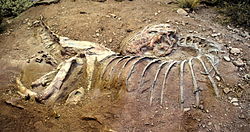Skorpiovenator
|
Skorpiovenator Temporal range: Late Cretaceous, 95 Ma |
|
|---|---|
 |
|
| Cast of the holotype specimen | |
| Scientific classification | |
| Kingdom: | Animalia |
| Phylum: | Chordata |
| Class: | Reptilia |
| Clade: | Dinosauria |
| Order: | Saurischia |
| Suborder: | Theropoda |
| Family: | †Abelisauridae |
| Clade: | †Brachyrostra |
| Genus: |
†Skorpiovenator Canale et al., 2008 |
| Type species | |
|
Skorpiovenator bustingorryi Canale et al., 2008 |
|
Skorpiovenator is a genus of abelisaurid theropod dinosaur from the late Cretaceous period of Argentina.
Skorpiovenator was estimated to have grown up to 6 m (19.7 ft) in length. In 2010, Gregory S. Paul gave larger estimations of 7.5 m (24.6 ft) and 1.67 tonnes (1.84 short tons). In 2016, a similar size to the original estimate at 6.2 m (20.3 ft) was estimated. It had short, stubby, near-useless arms, but strong legs with powerful thighs and sturdy shins over which its large body was balanced.
Skorpiovenator's skull was short, stout and covered in the ridges, furrows, tubercles and bumpy nodules that are scattered over the heads of most abelisaurid theropods. Its slender jaws housed rows of razor-sharp teeth.Skorpiovenator may not have had a large bite force, as has been suggested for some other abelisaurids. Skorpiovenator may have used its deep skull as a club, arching its head back and swinging it down onto its prey to drive the teeth home with enough force to do some serious damage to its prey.
The type specimen was described and named by Canale, Scanferla, Agnolin, and Novas in 2009 (though the paper was released as an advanced publication online in 2008). The name Skorpiovenator bustingorryi is derived from the Greek and Latin for "scorpion hunter," due to the abundant scorpions present at the dig site, and the specific name honors Manuel Bustingorry, who owned the farm where the specimen was found. The describers have defined a new name Brachyrostra for a clade, to which Skorpiovenator belonged.
The type species, Skorpiovenator bustingorryi, is known from a single, nearly complete skeleton (MMCH-PV 48K) missing only sections of the tail and the majority of the forelimbs. The specimen was recovered from the lower part of the Huincul Formation in Patagonia, dating to the late Cenomanian stage, about 95 million years ago. It would have lived alongside other carnivorous dinosaurs such as the carcharodontosaurid Mapusaurus and another abelisaurid, Ilokelesia.
...
Wikipedia
